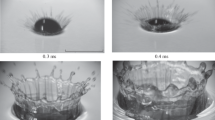Abstract
The process of disintegration of a drop (water, a saturated solution of ferrous sulfate, or alizarin ink) freely falling into water into fibers is first observed in the vicinity of the confluence line of liquids. Photo and video recording of the evolution of the flow pattern is carried out. At the bottom of the cavity, annular capillary waves covering the confluence area are visualized as well. Thin radial jets (ligaments) transporting droplet matter descending from the pointed crests of the perturbed boundary of the fluid confluence region are traced. In the mode of splash formation, the ligaments continue in the crown, penetrate the veil, and partially penetrate the spikes at the tops of the pointed teeth on its edge. Wakes of the jets colored by the drop substance form linear and reticulated structures deformed by flows and spreading out under the action of diffusion. Sprays, the sequences of gradually growing small droplets, fly out from the tips of the spikes, the size and angular position of which change with time. Additional acceleration of the fluid in the jets is associated with conversion of the available potential energy upon elimination of the free surfaces of the coalesced fluids.




Similar content being viewed by others
REFERENCES
W. B. Rogers, Am. J. Sci. Arts, Sec. Ser. 26, 246 (1858).
Lord Rayleigh, Proc. R. Soc. London, Ser. A 28, 406 (1879).
A. M. Worthington, A Study of Splashes (Longmans, Green, London, 1908), p. 129.
Lord Rayleigh, The Theory of Sound (Cambridge Univ. Press, Cambridge, 2011).
L. D. Landau and E. M. Lifshitz, Course of Theoretical Physics, Vol. 6: Fluid Mechanics (Nauka, Moscow, 1986; Pergamon, New York, 1987).
M. Rein, Fluid Dyn. Res. 12, 61 (1993). https://doi.org/10.1016/0169-5983(93)90106-K
V. Zhang, J. Toole, K. Fezzaa, and R. D. Deegan, J. Fluid Mech. 703, 402 (2012). https://doi.org/10.1017/jfm.2012.249
Yu. D. Chashechkin and A. Yu. Il’inykh, Dokl. Phys. 65, 75 (2020). https://doi.org/10.1134/S1028335820020020
S. T. Thoroddsen, M. J. Thoraval, K. Takehara, and T. G. Etoh, Phys. Rev. Lett. 106, 034501 (2011).https://doi.org/10.1103/PhysRevLett.106.034501
Yu. D. Chashechkin and A. Yu. Il’inykh, Dokl. Phys. 60, 548 (2015). https://doi.org/10.1134/S1028335815120022
Yu. D. Chashechkin and A. Yu. Il’inykh, Dokl. Phys. 66, 20 (2021).
Yu. D. Chashechkin and A. Yu. Il’inykh, Dokl. Phys. 63, 282 (2018). https://doi.org/10.1134/S1028335818070066
E. Berberovic, N. P. van Hinsberg, S. Jakirlic, I. V. Roisman, and C. Tropea, Phys. Rev. E 79, 1 (2009). https://doi.org/10.1103/PhysRevE.79.036306
Yu. D. Chashechkin, Izv., Atmos. Ocean. Phys. 55, 285 (2019). https://doi.org/10.1134/S0001433819020026
GFK IPMech RAS: Hydrophysical Complex for Modeling Hydrodynamic Processes in the Environment and their Impact on Underwater Technical Objects, as well as the Spread of Impurities in the Ocean and Atmosphere. http://www.ipmnet.ru/uniqequip/gfk/#equip.
Funding
This study was conducted on the stands of the Unique Research Installations of the Hydrophysical Complex at the Ishlinskii Institute for Problems in Mechanics, Russian Academy of Sciences. This work was supported by the Russian Science Foundation, project no. 19-19-00598.
Author information
Authors and Affiliations
Corresponding authors
Additional information
Translated by E. Oborin
Rights and permissions
About this article
Cite this article
Chashechkin, Y.D., Ilinykh, A.Y. Drop Decay into Individual Fibers at the Boundary of the Contact Area with a Target Fluid. Dokl. Phys. 66, 101–105 (2021). https://doi.org/10.1134/S1028335821040078
Received:
Revised:
Accepted:
Published:
Issue Date:
DOI: https://doi.org/10.1134/S1028335821040078




